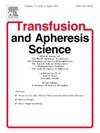Serological and secretor status analysis of Am phenotypes: Two cases from Northeast India
IF 1.2
4区 医学
Q4 HEMATOLOGY
引用次数: 0
Abstract
Background
In ABO blood grouping, a type II discrepancy refers to weak or absent antigen reactions in cell grouping, often indicating a weak ABO subgroup. The Am phenotype is a rare weak A subgroup variant, distinguished by absent agglutination with anti-A antisera and normal A substance in saliva. Reporting such rare phenotype is vital to improve awareness and diagnostic accuracy, especially in Northeast region of India, where access to advanced serological tools is limited.
Case details
During routine blood grouping, type II ABO discrepancies were noted in two cases. Comprehensive immunohematological workup, including cell grouping by conventional tube technique using different lectins and at varying temperatures, adsorption-elution studies, and secretor testing, was performed. Adsorption-elution studies confirmed weak A antigen expression. Secretor testing demonstrated the presence of A and H substances in saliva, consistent with Am phenotype.
Conclusion
Our cases highlight the diagnostic complexity of weak A subgroups. In resource-limited settings, with limited access to molecular diagnostics, detailed serological testing remains critical for ABO subgroup identification. Proper recognition of such phenotypes ensures transfusion safety and prevents misclassification.
印度东北部2例Am表型血清学及分泌状态分析
在ABO血型中,II型差异是指细胞分组中抗原反应弱或不存在,通常表明ABO亚群弱。Am表型是一种罕见的弱a亚群变异,其特点是与抗a抗血清和唾液中正常的a物质缺乏凝集。报告这种罕见的表型对于提高认识和诊断准确性至关重要,特别是在获得先进血清学工具有限的印度东北部地区。在常规血分组中,2例发现II型ABO差异。进行了全面的免疫血液学检查,包括使用不同凝集素和在不同温度下使用传统试管技术进行细胞分组,吸附-洗脱研究和分泌物测试。吸附-洗脱研究证实弱A抗原表达。分泌物检测显示唾液中存在A和H物质,与Am表型一致。结论我们的病例突出了弱A亚群诊断的复杂性。在资源有限的环境中,由于分子诊断方法有限,详细的血清学检测对于ABO亚群鉴定仍然至关重要。正确识别这些表型可确保输血安全并防止错误分类。
本文章由计算机程序翻译,如有差异,请以英文原文为准。
求助全文
约1分钟内获得全文
求助全文
来源期刊
CiteScore
3.60
自引率
5.30%
发文量
181
审稿时长
42 days
期刊介绍:
Transfusion and Apheresis Science brings comprehensive and up-to-date information to physicians and health care professionals involved in the rapidly changing fields of transfusion medicine, hemostasis and apheresis. The journal presents original articles relating to scientific and clinical studies in the areas of immunohematology, transfusion practice, bleeding and thrombotic disorders and both therapeutic and donor apheresis including hematopoietic stem cells. Topics covered include the collection and processing of blood, compatibility testing and guidelines for the use of blood products, as well as screening for and transmission of blood-borne diseases. All areas of apheresis - therapeutic and collection - are also addressed. We would like to specifically encourage allied health professionals in this area to submit manuscripts that relate to improved patient and donor care, technical aspects and educational issues.
Transfusion and Apheresis Science features a "Theme" section which includes, in each issue, a group of papers designed to review a specific topic of current importance in transfusion and hemostasis for the discussion of topical issues specific to apheresis and focuses on the operators'' viewpoint. Another section is "What''s Happening" which provides informal reporting of activities in the field. In addition, brief case reports and Letters to the Editor, as well as reviews of meetings and events of general interest, and a listing of recent patents make the journal a complete source of information for practitioners of transfusion, hemostasis and apheresis science. Immediate dissemination of important information is ensured by the commitment of Transfusion and Apheresis Science to rapid publication of both symposia and submitted papers.

 求助内容:
求助内容: 应助结果提醒方式:
应助结果提醒方式:


